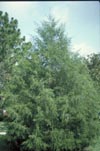Home >
Juniperus silicicola, Southern Redcedar
Planted in full sun or partial shade, Southern Redcedar will easily grow on a variety of soils, including clay. Growth may be poor in landscapes which are over-irrigated. Plants are difficult to transplant due to a coarse root system, except when quite small. Water until well-established and then forget about the tree. It performs admirably with no care, even on alkaline soil and along the coast once established. Usually insects and diseases are not a problem if grown in the full sun. There may be local restrictions on planting this tree near apple orchards because it is the alternate host for cedar-apple rust. Male trees generate copious amounts of pollen which cause significant allergy problems for many people; female trees produce fruit but no pollen.
Trees are naturally found in Florida south to Lee and Indian River Counties. Entire range is coastal North Carolina along the Gulf coast in southeastern US into south central Florida and Texas. Often along tidal marshes on limestone outcroppings and on the leeward side of dunes. Colonizes abandoned farm fields on well-drained soils; usually not on saturated soils but can be found on soils that drain poorly.
Natural habitat is dry and windy with full sun exposure. It looks best in an open site with no shade during the day. This allows the foliage to dry quickly in the morning and helps prevent foliage disease from thinning the canopy. A well-drained soil is essential for good growth. Wet soil rots the roots and causes plant decline.
Prune to a single leader to help prevent breakage in storms. Do this by removing leaders than compete with the one you have chosen to become the main leader.
I have not been able to figure out why we have not embraced this versatile tree more in American landscapes. Why search off the continent for ornamental and environmentally friendly plants when we have a great one right here at home. There are many, many opportunities to select outstanding cultivars. Some day one grower will figure out that there is a market for cultivars of this wonderful native. Very susceptible to deep planting.
This
tree is a great substitute for the disease-prone leyland cypress.





